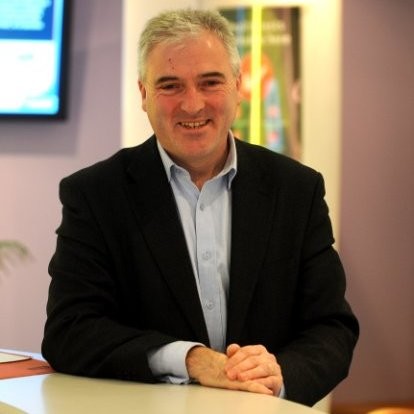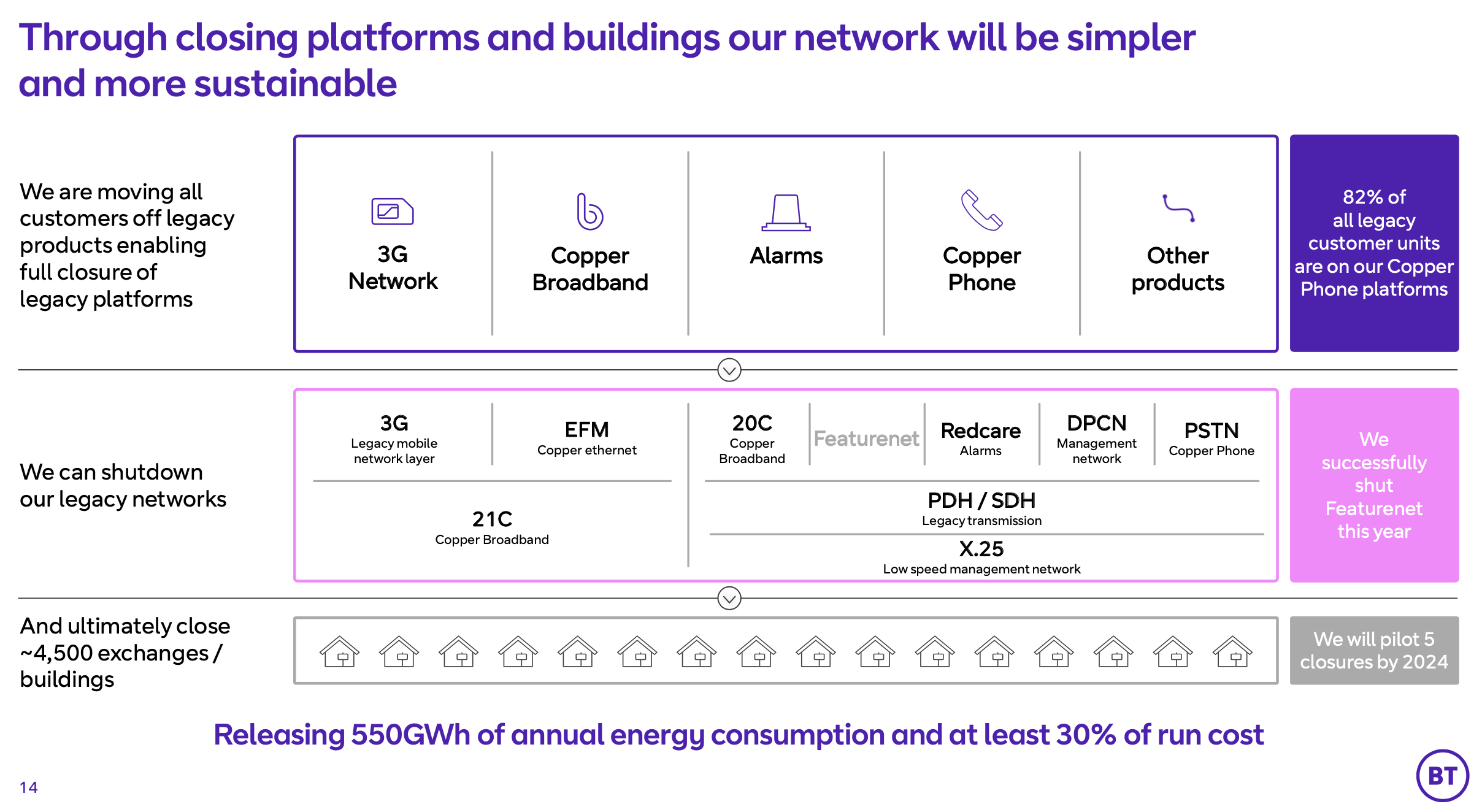“We obsess about something called the bits per second per hertz per megawatt,” said Professor Tim Whitley, managing director for applied research at BT, during a recent BT Networks investor briefing.
Howard Watson, BT’s chief technology and information officer, picked up on the same BT energy efficiency metric: “That’s the real challenge into the supply chain now. It's not just good enough to give us better spectral efficiency – that efficiency measure also has to include energy consumption.”
As a name, it’s a bit of a mouthful – but it’s the ultimate measure of “how much capacity you can get out of the fuel of a mobile network”. And it’s clear from the briefing the whole BT Networks team has energy on their mind. While that’s true of almost everyone in the world right now, BT has more reason to care than most.
The BT energy efficiency mountain

BT consumes 2.5 terawatt hours (TWh) of electricity a year (and another 200 gigawatt hours (GWh) of oil and gas), or about 0.75% of the UK’s total electricity consumption for 2021. For a single organisation that’s a significant achievement.
It’s also why BT energy efficiency is a priority. According to Emily Clark, chief financial officer at BT Networks, even though 84% of its energy this financial year, and 50% next, is hedged, energy costs are still up 80% within those hedging agreements. Clark said BT aims to move to longer term power supply agreements, which currently account for about 17% of the telco's needs.
Throughout the investor briefing figures for energy consumption were close at hand: according to Watson fibre-to-the-curb (FTTC) broadband consumes 2.4 watts per customer, fibre-to-the-premises (FTTP) just 0.3 watts. (In a sly dig at BT’s main broadband network competitor, Virgin Media, he suggested its DOCSIS technology uses 5 watts per customer.)
“A statistic for you that I might not want to share, but I'm going to now: if you walk into an exchange building, look at electronic equipment inside an exchange, approaching half of it is powered down,” because it is no longer needed, Watson told analysts during the briefing. “What we've now got to do is make sure that we responsibly remove all of that infrastructure.”
This is BT’s next big challenge: closing down 4,500 of its 5,600-odd telephone exchanges, and shutting down the legacy network equipment within them. This alone will boost BT energy efficiency, cutting 550 GWh from its power bill, according to Watson – as well as freeing up valuable real estate, and allowing an enormous amount of old infrastructure to be recycled, which BT estimates will yield about 200,000 tonnes of valuable copper.

The long road to exchange optimisation
But this is a long process, and one which hit a bump when BT had to delay the first stage – migrating customers to digital voice – because of customer complaints in early 2022. Watson said BT was still on track to migrating to digital voice and PSTN switch-off by December 2025, with a long-term goal of closing down most of its exchanges by 2035/36.
“We're piloting the closure [by 2024] of five exchanges right now, one here in London, to understand that the ramifications of that and to make sure that we take customers on that journey with us,” said Neil McRae, BT’s chief architect.
“We have actually selected around 100 that we think are some of the prime buildings, i.e. they're the ones that the property team is saying to me, please get out of these first, please get out of these. And we do intend to get out of that 100 between now and the end of the decade,” added Watson.
Follow The Stack on LinkedIn

He also suggested exchange buildings – as well as FTTC cabinets (those small green enclosures now seen on most streets in the UK) – may find uses for edge compute applications. BT is still exploring how best to use edge compute – Whitley referenced uses for applications such as volumetric video.
One thing the telco will do at the edge is get closer to hyperscalers such as AWS and Google Cloud through colocation, “bringing our network close to them, enabling us to market their services to our customers and work in partnership with the public cloud” according to McRae.
The hyperscalers have also inspired BT’s “Network Cloud”, designed to allow the telco’s network to scale up and down as needed, creating the “network-as-a-service” which Harmeen Mehta, BT’s chief digital and innovation officer, referenced heavily during an earlier investor briefing.
See: BT’s ‘reverse flywheel’ problem
Network Cloud is currently in 12 locations with 2,000 servers, according to McRae: “It's all software driven. We're leveraging the latest telemetry and API-based technology and cloud native technology to enable a platform that scales as we as we need it. And then also allows us to effectively run applications under our control under the demands that we as a telco have, as opposed to what the hyperscalers can offer us, and crucially, allows us to scale up and down.
“The network itself becomes an object in programming so that you can as a customer, or as a developer, or as a as a member inside BT, you can write code to create a piece of network, that could be a high speed path from London to Glasgow, it could be an SMS service, it could be a voicemail service. But through APIs, you're able to set up a network capability, leverage it in the way that you want, and then and then stop using it,” he added.
While the flexibility of Network Cloud promises to be very powerful, in the meantime BT must find ways to manage capacity and optimise the efficiency of its core network, which at its peak handles 28 Tbps of data, 25 Tbps via broadband, and 3Tbps by Ethernet.
Cutting costs through caching
According to Watson. One of the key ways BT reduces its load remains caching: “We've been using Qwilt which is a form of open cache, working with content partners there, which means we get a bit of a share in the revenue as well, so that helps to fund that. It’s actually quite a large amount [of data]; I mean, if we took caching away, the 28 Tbps that we currently have now would be much higher.”

He also said that content providers, including video streamers and streaming games platforms, have recognised the value in working with network providers on launches: “The content guys realise that it's not just about kind of chucking it on the network and hoping – they actually want to ensure that when they put their programme, if you're Disney and you’re launching Mandalorian season four, you want that to be a phenomenal experience.”
Watson noted during the height of pandemic lockdowns, McRae was able to persuade Call of Duty and Fortnite “not to co-launch their products at 7pm every evening at the same time, and to help by spreading that across the day”.
And with broadcast TV moving onto IP-based networks, he said there remains the challenge of converting a unicast IP stream, which can’t be cached, to multicast, which would significantly reduce the burden on the core network.
Eyes on BT energy efficiency prize
Still chasing those BT energy efficiency goals, McRae said the telco is in the process of switching 100 gig optical networking to 200 gig, and 400 gig to 800 thanks to Nokia’s platform. Looking further ahead, McRae has hopes for OpenRAN's flexibility contributing to energy reduction, while Whitley said the telco’s labs are working with universities on “hollow core optical fibre”, and also on Massive MIMO and Ultra MIMO, which is able to boost data rates by a factor of 10.
Ultimately, the priority for BT Networks remains simple (if a mouthful): bits per second per hertz per megawatt. This keeps falling – the challenge will be if it’s falling fast enough.








